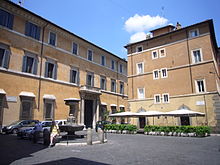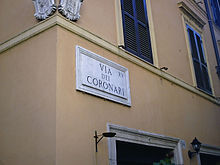This is an old revision of this page, as edited by Daniel J. Leivick (talk | contribs) at 16:13, 16 March 2015 (→Notable buildings and landmarks: grammar clean up). The present address (URL) is a permanent link to this revision, which may differ significantly from the current revision.
Revision as of 16:13, 16 March 2015 by Daniel J. Leivick (talk | contribs) (→Notable buildings and landmarks: grammar clean up)(diff) ← Previous revision | Latest revision (diff) | Newer revision → (diff)
41°54′02.80″N 12°28′10.50″E / 41.9007778°N 12.4695833°E / 41.9007778; 12.4695833 Via dei Coronari (known colloquially in Rome as I Coronari) is a street in the historic center of Rome. The road, flanked by buildings mostly erected in the 15th and the 16th century, belongs entirely to the rione Ponte. Via dei Coronari is one of the most picturesque roads of the old city, having maintained the character of an Italian Renaissance street.
Location
Via dei Coronari is about 500m long and runs in E-W direction, between Largo di Tor Sanguigna and Piazza dei Coronari. From there, Vicolo del Curato is its west extension. Behind Tor Sanguigna, the straight path continues east passing under a scenic arch into Via di S. Agostino and Via della Coppelle. The continuity between Via dei Coronari and the latter roads was destroyed in the 1910s through the opening of Via Zanardelli.
Via dei Coronari forms the north border of the neighborhood of Tor di Nona, and to the southwest the small hill named Monte Giordano, topped by the mighty Palazzo Taverna.
History

The road existed already in the Roman age, when it was part of the straight road correspondent to the modern axis Via della Coppelle – Via dei Coronari, known under the arbitrary name of Via recta ("straight road").
The street name comes from the Coronari: these, also named Paternostrari, were the rosary beads ("corone" in Italian), holy miniatures and other holy objects sellers, who had their shops along the road: these were strategically situated, since the way, leading to the Pons Aelius, was part of the itinerary to the Basilica of St. Peter which the bigger part of the pilgrims, entering Rome from the Porta del Popolo, were forced to walk along.
During the middle Ages, the road linked together two different neighborhoods: the Scorticlaria (a toponimy used between the 10th and the 15th century, which during the Middle Ages became also part of the rione's name: Regio Ponti et Scorticlarorum) to the East, so called because of the many dealers in leather (Template:Lang-la) goods having their shops there; and the Immagine di Ponte ("Ponte's image") to the West, named after a wayside shrine rebuilt in the 16th century on a corner of Palazzo Serra and still in place. This was commissioned by Protonotary apostolic Alberto Serra di Monferrato to Antonio da Sangallo the Younger.
During the Renaissance, the street was paved and rectified by pope Sixtus IV (r. 1471–84). As in other roads of the city, the pope ordered to wall up all the porticoes which flanked the street, which due to that lost its medieval character. High prelates, nobles and merchants, attracted by the fiscal advantages promised by the pope to those who had built there, erected their elegant houses and palaces here, whose façades were often adhorned with Sgraffito paintings, most of whom now faded away. Many houses bore (and some still bear) etched over marble plates, the motto of the owner, which give us a hint about his philosophy of life.
In the same period, the neighborhood became home to several decent prostitutes, the cortigiane, high educated women who were lovers of high prelates and aristocrats: among them was Fiammetta Michaelis (the lover of Cesare Borgia), whose home still exists in the part of the road west of S. Salvatore in Lauro.
After the Renaissance, the road and its surroundings decayed. The well off moved from the Renaissance quarter further north to the rione Campo Marzio, in the zone of Piazza di Spagna.
After the Italian conquest of Rome in 1870, there was a project to enlarge the road, but the mayor of Rome of that time, Ernesto Nathan, canceled it.
The road has been largely spared by the demolitions which affected central Rome in the fascist period. Nevertheless, in 1939, because of the policy of diradamento ("thinning"), carried out by the city government in the old center, which envisaged the destruction of single blocks in order to lower the population density, the street lost its unity because of demolitions north of the church of San Salvatore in Lauro and near Via Vecchiarelli.
Starting with the 1950s, the shops of the road were occupied by many junk-dealers, which with time became antique dealers, transforming the road into one of the three centers of the art commerce in Rome, together with Via Giulia and Via del Babuino. Since the 2000s, many of these shops have been substituted with others, like pizzerias, gelaterias and souvenir sellers, servicing tourists en route to St. Peter.
Notable buildings and landmarks


- Palazzo Lancellotti. The Lancellotti are a noble Roman family, originating from Sicily. They belong to the black nobility ("nobiltà nera"), these nobles which have remained faithful to the pope after the Italian conquest of Rome in 1870. To show their fidelity, the door of the palace on the piazza di San Simone has remained closed since that day. The building has been designed by Francesco Capriani da Volterra around the middle of the 16th century, and finished by Carlo Maderno. The door has been designed by Domenichino.
- Palazzo del Drago, a noble family originating from Viterbo, erected around the middle of the 16th century;
- Palazzo dell`antico Monte di Pietà, rebuilt in 1785. The Roman Mount of Piety was founded in 1585 by Pope Sixtus V (r. 1585–90), who bought at his own expense a house here.
- Vicolo di S. Trifone, Rome's narrowest lane;
- Fountain of Piazzetta di S. Simeone, in front of Palazzo Lancellotti, erected in Piazza Montanara in rione Campitelli (destroyed in the 1920s) and brought here in 1973;
- Church of S. Salvatore in Lauro dei Piceni, the national church of the immigrants from Marche in Rome;
- Church of S. Simone and Giuda, at the top of a high stair climbing Monte Giordano: desecrated in 1901, it was later used as cinema and theater;
- House of Prospero Mochi, Abbreviator at the Pope's court and general commissioner of Rome's and Borgo's fortifications during the reign of pope Paul III (r. 1534–49), erected in the 16th century. On the door's architrave, it is etched the owner's Latin motto: "Tua puta que tute facis" (Template:Lang-en).
- House of Fiammetta, the lover of Cesare Borgia, erected in the 15th century but with anachronistic medieval elements;
- Immagine di Ponte ("Ponte's Image"), a 16th-century marble wayside shrine, erected around 1523: it was designed by Antonio da Sangallo the Younger, and frames a Virgin Mary, work of Perin del Vaga;
- House said to have been bought by Raphael (or, more probably, by his heirs) to endow his tomb in the Pantheon;
- Monte Giordano, a small artificial hill created in Roman times with the debris of the nearby Tiber harbour. In the Middle Ages, Monte Giordano was a stronghold of the noble Orsini family.
Notes
- ^ Pietrangeli (1981) II, p.5
- Pietrangeli (1981) I, p.11
- Coarelli (1975)
- "The "Paternostrari"". giubileo.baicr.it. Consorzio BAICR Sistema Cultura. Retrieved 11 February 2015.
- Pietrangeli (1981) I, p.9
- Gnoli, sub voce "Scorticlaria" and "Immagine di Ponte"
- ^ Castagnoli & others (1958)
- Pietrangeli (1981) I, p.8
- ^ Pietrangeli (1981) II, p.24
- Monaco, Luca (10 November 2014). "Via dei Coronari, piano antidegrado. "In strada le pattuglie della legalità"" (in Italian). Repubblica. Retrieved 9 March 2015.
- ^ Pietrangeli (1981) II, p. 12
- Pietrangeli (1981) II, p.16
- ^ Pietrangeli (1981) II, p.14
- Pietrangeli (1981) II, p.10
- Pietrangeli (1981) II, p.22
- Pietrangeli (1981) II, p.26
- Pietrangeli (1981) II, p.30
- Pietrangeli (1981) II, pp.32–42
Sources
- Baronio, Cesare (1697). Descrizione di Roma moderna (in Italian). M.A. and P.A. De Rossi, Roma.
- Castagnoli, Ferdinando; Cecchelli, Carlo; Giovannoni, Gustavo; Zocca, Mario (1958). Topografia e urbanistica di Roma (in Italian). Bologna: Cappelli.
- Delli, Sergio (1975). Le strade di Roma (in Italian). Rome: Newton Compton.
- Pietrangeli, Carlo (1981). Guide rionali di Roma (in Italian). Vol. Ponte (I-IV). Fratelli Palombi Editori, Roma. ISSN 0395-2710.
- Coarelli, Filippo (1975). Guida Archeologica di Roma (in Italian). Milan: Mondadori. ISBN 0-520-07961-2.
- Gnoli, Domenico (1990). Topografia e toponomastica di Roma medievale e moderna (in Italian). Roma: Grotta del Libro.